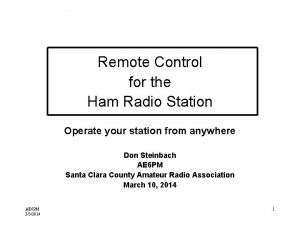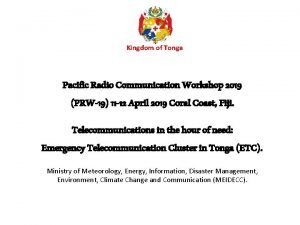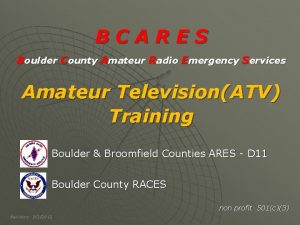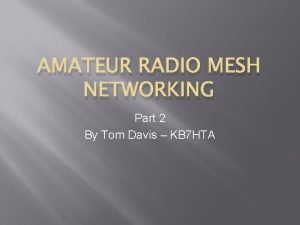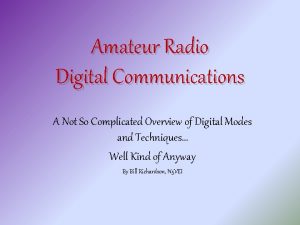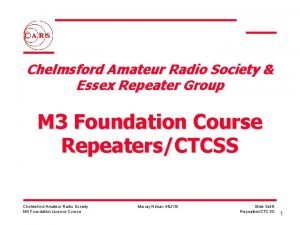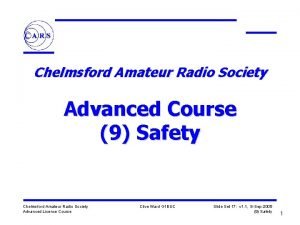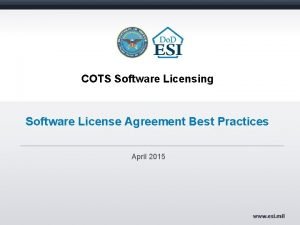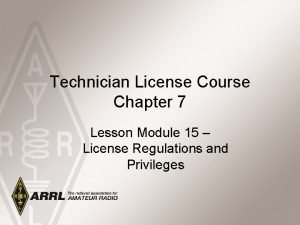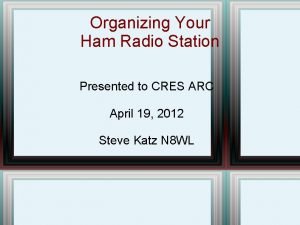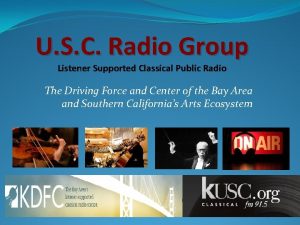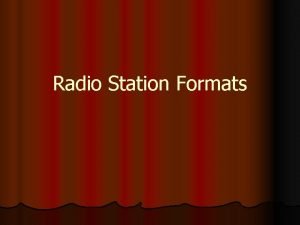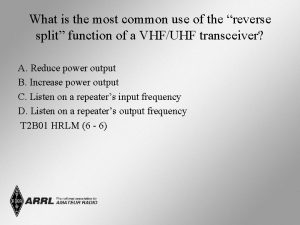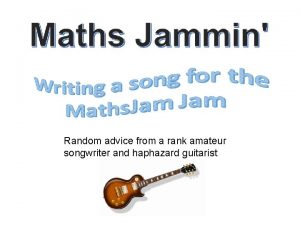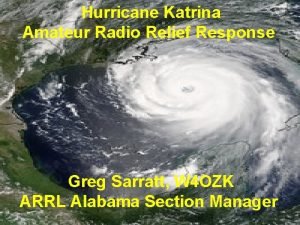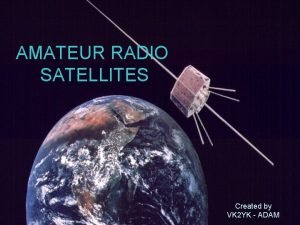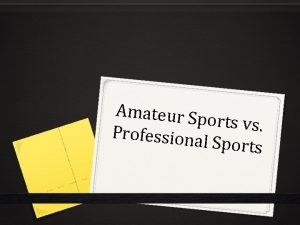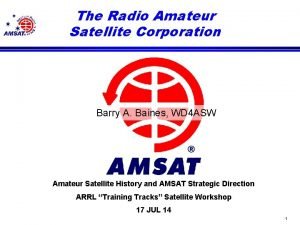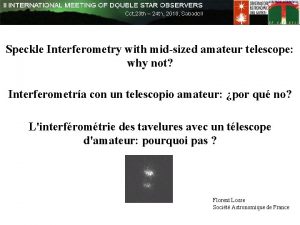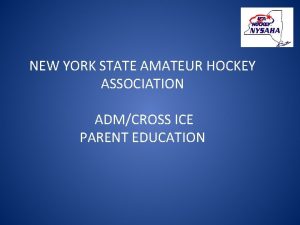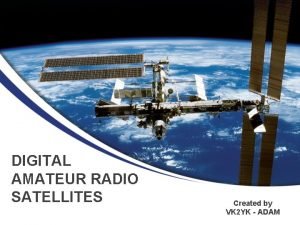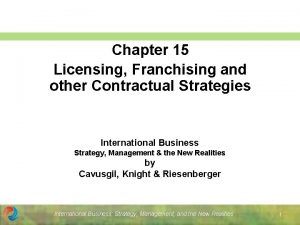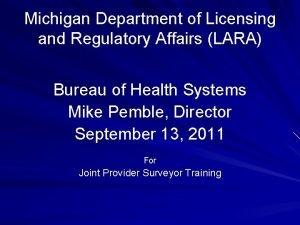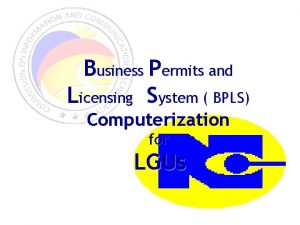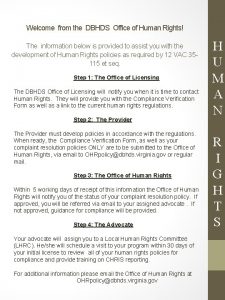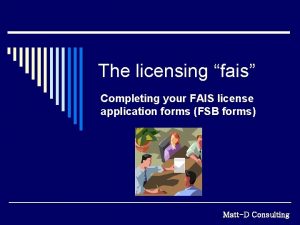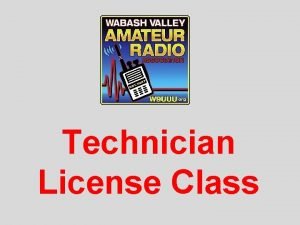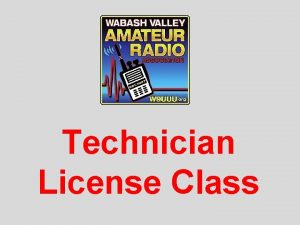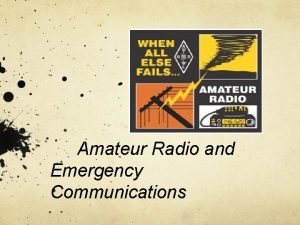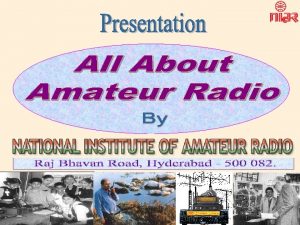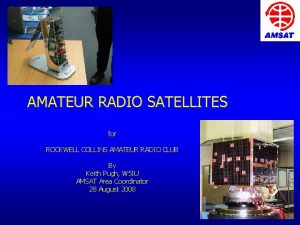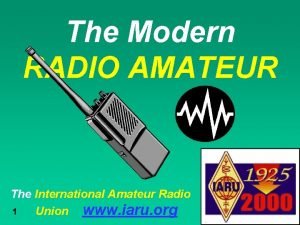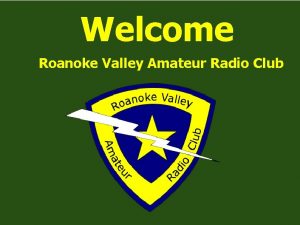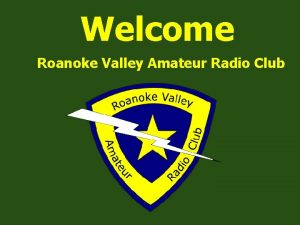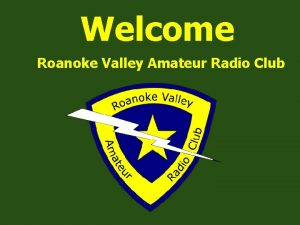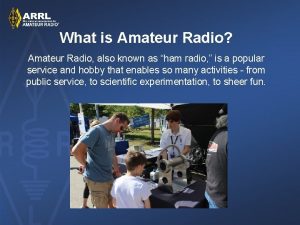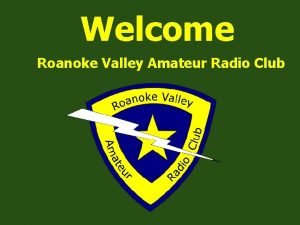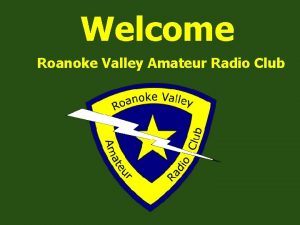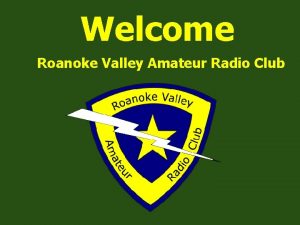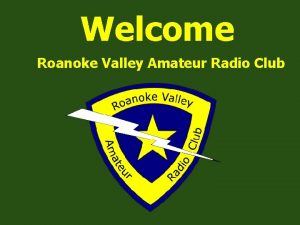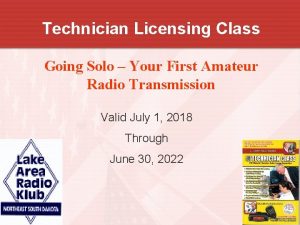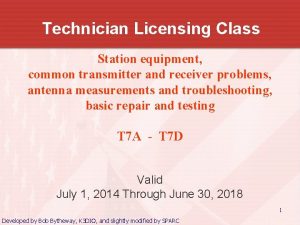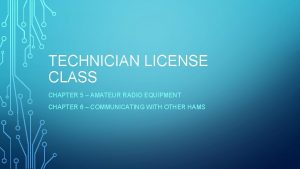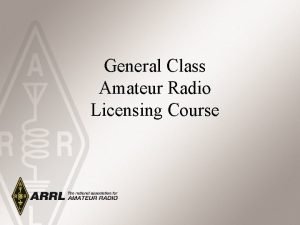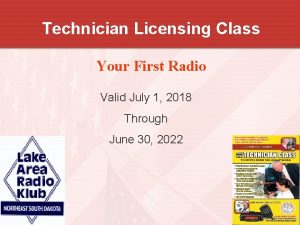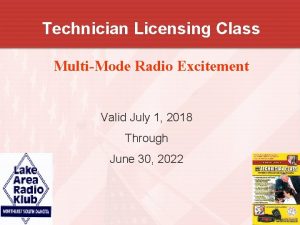Technician Licensing Class Amateur radio practices and station










































- Slides: 42

Technician Licensing Class Amateur radio practices and station setup T 4 A - T 4 B Valid July 1, 2018 Through June 30, 2022 Developed by Bob Bytheway, K 3 DIO, and updated to 2018 Question Pool by NQ 4 K for Sterling Park Amateur Radio Club 1

T 4 A • Station setup: • connecting microphones; • reducing unwanted emissions; • power source; • connecting a computer; • RF grounding; • connecting digital equipment; • connecting an SWR meter 2

T 4 A • The following must be considered to determine the minimum current capacity needed for a transceiver power supply. • Efficiency of the transmitter at full power output • Receiver and control circuit power • Power supply regulation and heat dissipation T 4 A 01 3

T 4 A • Computers might be used as part of an amateur radio station: • For logging contacts and contact information • For sending and/or receiving CW • For generating and decoding digital signals T 4 A 02 4

T 4 A • Wiring between the power source and radio be heavy-gauge wire and kept as short as possible to avoid voltage falling below that needed for properation. T 4 A 03 • The transceiver’s headphone or speaker output is connected to a computer’s microphone or line input for operating digital modes T 4 A 04 5

T 4 A • An external standing wave ratio (SWR) meter may be located in series with the feed line, between the transmitter and antenna. T 4 A 05 6

T 4 A • Receive audio, transmit audio, and push-to-talk (PTT) connections might be used between a voice transceiver and a computer for digital operation. T 4 A 06 • When conducting digital communications using a computer the sound card provides audio to the microphone input and converts received audio to digital form. T 4 A 07 7

T 4 A • The flat strap type of conductor is the best to use for RF grounding. T 4 A 08 • Use a ferrite choke to cure distorted audio caused by RF current flowing on the shield of a microphone cable. T 4 A 09 8

T 4 A • A source of a high-pitched whine that varies with engine speed in a mobile transceiver’s receive audio is the alternator. T 4 A 10 • The negative return connection of a mobile transceiver power cable should be connected at the battery or engine block ground strap. T 4 A 11 9

T 4 B • Operating controls: • tuning; • use of filters; • squelch function; • AGC; • transceiver operation; • memory channels 10

T 4 B • If a transmitter is operated with the microphone gain set too high the output signal might become distorted • A keypad or VFO knob can be used to enter the operating frequency on a modern transceiver. T 4 B 01 T 4 B 02 Key. Pad VFO • The squelch control on a transceiver will mute the receiver output noise when no signal is being received. 11 T 4 B 03

Run Some Interference Protection • Storing popular frequencies in a memory channel is a way to enable quick access to a favorite frequency on your transceiver. T 4 B 04 • To reduce ignition interference to a receiver turn on the noise blanker. T 4 B 05 Not on common FM handheld or mobile FM radios. On bigger highfrequency, multimode transceiver. NB – Noise Blanker 12

T 4 B • The receiver incremental tuning (RIT) or clarifier controls could be used if the voice pitch of a singlesideband signal seems too high or low. T 4 B 06 • “RIT” means Receiver Incremental Tuning. T 4 B 07 13

T 4 B • The advantage of having multiple receive bandwidth choices on a multimode transceiver is that it permits noise or interference reduction by selecting a bandwidth matching the mode. T 4 B 08 14

T 4 B • 2400 Hz is an appropriate receive filter bandwidth to select in order to minimize noise and interference for SSB reception. T 4 B 09 15

T 4 B • 500 Hz is an appropriate receive filter bandwidth to select in order to minimize noise and interference for CW reception. T 4 B 10 16

T 4 B • The function of automatic gain control or AGC is to keep received audio relatively constant. T 4 B 11 • The following could be used to remove power line noise or ignition noise: • Squelch • Noise blanker • Notch filter T 4 B 12 17

Element 2 Technician Class Question Pool T 4 A–T 4 B 18

T 4 A 01 What must be considered to determine the minimum current capacity needed for a transceiver power supply? A. Efficiency of the transmitter at full power output B. Receiver and control circuit power C. Power supply regulation and heat dissipation D. All of these choices are correct 19

T 4 A 02 How might a computer be used as part of an amateur radio station? A. For logging contacts and contact information B. For sending and/or receiving CW C. For generating and decoding digital signals D. All of these choices are correct 20

T 4 A 03 Why should wiring between the power source and radio be heavy-gauge wire and kept as short as possible? A. To avoid voltage falling below that needed for properation B. To provide a good counterpoise for the antenna C. To avoid RF interference D. All of these choices are correct 21

T 4 A 04 Which computer sound card port is connected to a transceiver’s headphone or speaker output for operating digital modes? A. Headphone output B. Mute C. Microphone or line input D. PCI or SDI 22

T 4 A 05 What is the proper location for an external SWR meter? A. In series with the feed line, between the transmitter and antenna B. In series with the station’s ground C. In parallel with the push-to-talk line and the antenna D. In series with the power supply cable, as close as possible to the radio 23

T 4 A 06 Which of the following connections might be used between a voice transceiver and a computer for digital operation? A. Receive and transmit mode, status, and location B. Antenna and RF power C. Receive audio, transmit audio, and push-to-talk (PTT) D. NMEA GPS location and DC power 24

T 4 A 07 How is the computer’s sound card used when conducting digital? A. The sound card communicates between the computer CPU and the video display B. The sound card records the audio frequency for video display C. The sound card provides audio to the microphone input and converts received audio to digital form D. All of these choices are correct 25

T 4 A 08 Which of the following conductors provides the lowest impedance to RF signals? A. Round stranded wire B. Round copper-clad steel wire C. Twisted-pair cable D. Flat strap 26

T 4 A 09 Which of the following could you use to cure distorted audio caused by RF current on the shield of a microphone cable? A. Band-pass filter B. Low-pass filter C. Preamplifier D. Ferrite choke 27

T 4 A 10 What is the source of a high-pitched whine that varies with engine speed in a mobile transceiver’s receive audio? A. The ignition system B. The alternator C. The electric fuel pump D. Anti-lock braking system controllers 28

T 4 A 11 Where should the negative return connection of a mobile transceiver’s power cable be connected? A. At the battery or engine block ground strap B. At the antenna mount C. To any metal part of the vehicle D. Through the transceiver’s mounting bracket 29

T 4 B 01 What may happen if a transmitter is operated with the microphone gain set too high? A. The output power might be too high B. The output signal might become distorted C. The frequency might vary D. The SWR might increase 30

T 4 B 02 Which of the following can be used to enter the operating frequency on a modern transceiver? A. The keypad or VFO knob B. The CTCSS or DTMF encoder C. The Automatic Frequency Control D. All of these choices are correct 31

T 4 B 03 What is the purpose of the squelch control on a transceiver? A. To set the highest level of volume desired B. To set the transmitter power level C. To adjust the automatic gain control D. To mute receiver output noise when no signal is being received 32

T 4 B 04 What is a way to enable quick access to a favorite frequency on your transceiver? A. Enable the CTCSS tones B. Store the frequency in a memory channel C. Disable the CTCSS tones D. Use the scan mode to select the desired frequency 33

T 4 B 05 Which of the following would reduce ignition interference to a receiver? A. Change frequency slightly B. Decrease the squelch setting C. Turn on the noise blanker D. Use the RIT control 34

T 4 B 06 Which of the following controls could be used if the voice pitch of a single-sideband signal seems too high or low? A. The AGC or limiter B. The bandwidth selection C. The tone squelch D. The receiver RIT or clarifier 35

T 4 B 07 What does the term "RIT" mean? A. Receiver Input Tone B. Receiver Incremental Tuning C. Rectifier Inverter Test D. Remote Input Transmitter 36

T 4 B 08 What is the advantage of having multiple receive bandwidth choices on a multimode transceiver? A. Permits monitoring several modes at once B. Permits noise or interference reduction by selecting a bandwidth matching the mode C. Increases the number of frequencies that can be stored in memory D. Increases the amount of offset between receive and transmit frequencies 37

T 4 B 09 Which of the following is an appropriate receive filter bandwidth for minimizing noise and interference for SSB reception? A. 500 Hz B. 1000 Hz C. 2400 Hz D. 5000 Hz 38

T 4 B 10 Which of the following is an appropriate receive filter bandwidth for minimizing noise and interference for CW reception? A. 500 Hz B. 1000 Hz C. 2400 Hz D. 5000 Hz 39

T 4 B 11 What is the function of automatic gain control, or AGC? A. To keep received audio relatively constant B. To protect an antenna from lightning C. To eliminate RF on the station cabling D. An asymmetric goniometer control used for antenna matching 40

T 4 B 12 Which of the following could be used to remove power line noise or ignition noise? A. Squelch B. Noise blanker C. Notch filter D. All of these choices are correct 41

T 4 B 13 Which of the following is a use for the scanning function of an FM transceiver? A. To check incoming signal deviation B. To prevent interference to nearby repeaters C. To scan through a range of frequencies to check for activity D. To check for messages left on a digital bulletin board 42
 Ham radio remote
Ham radio remote Tonga ham radio
Tonga ham radio Boulder amateur radio club
Boulder amateur radio club Ubiquiti link calculator download
Ubiquiti link calculator download Amateur radio digital communications
Amateur radio digital communications Chelmsford amateur radio society
Chelmsford amateur radio society Chelmsford amateur radio society
Chelmsford amateur radio society Chelmsford amateur radio society
Chelmsford amateur radio society Bbhn
Bbhn Cots license
Cots license Technician class privileges
Technician class privileges Ham radio station layout
Ham radio station layout Ham radio station layout
Ham radio station layout Classical usc
Classical usc Radio station music formats
Radio station music formats Teacher and student amateur
Teacher and student amateur Conventional radio system
Conventional radio system Where may ssb phone be used in amateur bands above 50 mhz?
Where may ssb phone be used in amateur bands above 50 mhz? Random amateur
Random amateur Club lust production
Club lust production Katrina amateur
Katrina amateur Vk amateur
Vk amateur Amateur revenge
Amateur revenge Amateur sp
Amateur sp Amateur sdx
Amateur sdx Japanese amateur hot
Japanese amateur hot Cysterelin
Cysterelin Telescopio amateur
Telescopio amateur New york state amateur hockey association
New york state amateur hockey association Signalink usb occasion
Signalink usb occasion Module 4 - open source software and licensing
Module 4 - open source software and licensing Ldh health standards
Ldh health standards Licensing franchising and other contractual strategies
Licensing franchising and other contractual strategies Michigan department of licensing and regulation
Michigan department of licensing and regulation Licensing and regulation division
Licensing and regulation division Bpls system
Bpls system Vet tech pros and cons
Vet tech pros and cons Radar and sonar technician career cluster
Radar and sonar technician career cluster Mbitr radio class
Mbitr radio class Wi dhs ems
Wi dhs ems Veritas backup exec capacity edition lite
Veritas backup exec capacity edition lite Dbhds office of licensing
Dbhds office of licensing Fais penn state
Fais penn state
